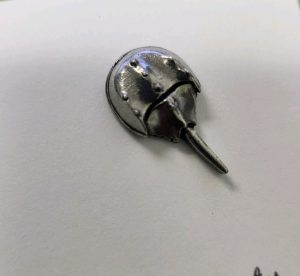Since 2018, volunteers in Hernando have been diligently tagging horseshoe crabs as part of an ongoing statewide effort to study and conserve these fascinating creatures. Horseshoe crabs are known to come ashore during the new and full moons at high tide during the spring and fall months, and sightings of tagged individuals provide valuable data for scientists. By reporting sightings of tagged horseshoe crabs, you can contribute to the ongoing research of this ancient species, while also earing rewards for your efforts.

Why Report Tagged Horseshoe Crab Sightings?
Horseshoe crabs play an important role in marine ecosystems and human health. They are a key food source for various shorebirds and other marine life. Additionally, their blue blood contains a compound called Limulus Amebocyte Lysate (LAL), which is used in medical research to test for bacterial endotoxins in pharmaceuticals and vaccines.
By reporting tagged horseshoe crabs sightings, you provide scientists with data on their movement, distribution, and population trends. This information is used to develop effective conservation strategies and managing their populations sustainably.
How to Report a Sighted Tagged Horseshoe Crab
When you see a tagged horseshoe crab in Hernando, follow these steps to report your sightings:
1. Observe Carefully: Look for the tag on the crab. Tags are typically located on the left side of the carapace (shell).
2. Note the Details: Record the tag number, if possible, along with the location, date, and time of the sighting. Also note the size and condition of the crab (alive or dead).
3. Report Online or Call In: You can report the sighting online or by calling 1-800-448-8322.
4. Handle with Care: Do not pick up the crab by the tail, as this can cause harm. If you must handle the crab, do so gently. Please leave the tag intact and attached to the crab.

Rewards for Reporting
When you report a tagged horseshoe crab sighting, you are not only aiding in scientific research but also receiving a token of appreciation from the U.S. Fish and Wildlife Service. They will end you a certificate and a crab lapel pin as a thank you for your contribution (while supplies last). It’s a small yet meaningful reward for participating in this citizen science intiative.
Horseshoe Crabs: Ancient and Vital
Horseshoe crabs have been around for over 450 million years, making them one of the oldest species on the planet. They are often referred to as “living fossils” due to their long history and unchanged appearance. Despite their tough exoskeletons and ancient lineage, horseshoe crabs face threats from habitat loss, overharvesting, and use in the medical industry.
So, the next time you visit the shorelines of Hernando County during high tide on a new or full moon, keep an eye out for tagged horseshoe crabs. Your sightings could provide valuable data for ongoing research efforts, ensuring the survival of these remarkable animals for years to come.
 2
2
